Ruminations on Ice and Fire
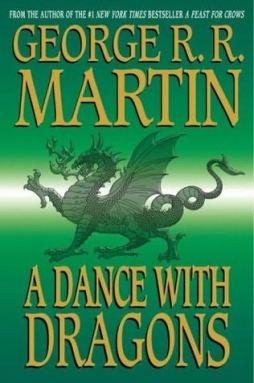 I recently had the chance to review George R.R. Martin’s A Dance With Dragons for my hometown newspaper, The Montreal Gazette. Looking at both the new volume and the previous four installments in his Song of Ice and Fire series, I found myself wondering what it is that makes the books work so well both with critics and a mass audience.
I recently had the chance to review George R.R. Martin’s A Dance With Dragons for my hometown newspaper, The Montreal Gazette. Looking at both the new volume and the previous four installments in his Song of Ice and Fire series, I found myself wondering what it is that makes the books work so well both with critics and a mass audience.
A Dance With Dragons reached the top of the best-seller lists in its first week of release, and had the highest first-day sales of any fiction book this year. The initial wave of reviews were widely positive, with glowing praise from Jeff VanderMeer and Lev Grossman among others (I liked it, too). There have been some dissenting opinions, though, one example of which is Theo’s post from earlier today. Oddly, it seems many of the people most disenchanted with the book have been (some) long-standing fans.
Perhaps it’s not so odd. It’s been six years since the last book in the series came out, and another five years since the book before that. Because of the way Martin structured these books, that means fans have been waiting to read about some of their favourite characters for eleven years. That’s quite a while; longer than the gap between the cancellation of the original Star Trek TV series and the premiere of Star Trek: The Motion Picture, for example. Expectations had to have been running high. But this only brings me back to what I was wondering before: why have people been waiting so fervently for the book?
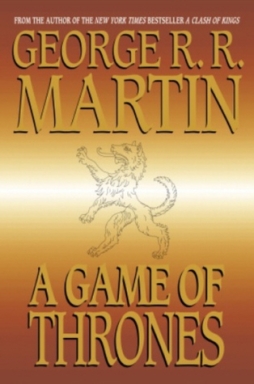 Well, the mystery of what attracts a mass audience seems to be beyond any easy solution. But I can say why I think the books work, and what stands out for me as I read them. Fundamentally, that’s the quality of Martin’s prose, and the way his style reflects his story structure and what appear to be his overall themes. (I say “appear to be” because I can only judge based on five books out of a projected seven. But with almost 5000 pages of text to look at, near 2 million words of story, certainly a few tentative conclusions can be drawn.)
Well, the mystery of what attracts a mass audience seems to be beyond any easy solution. But I can say why I think the books work, and what stands out for me as I read them. Fundamentally, that’s the quality of Martin’s prose, and the way his style reflects his story structure and what appear to be his overall themes. (I say “appear to be” because I can only judge based on five books out of a projected seven. But with almost 5000 pages of text to look at, near 2 million words of story, certainly a few tentative conclusions can be drawn.)
I don’t think of Martin as a distinctive prose stylist like, say, VanderMeer, or Greer Gilman, or John Crowley; that is, as a writer whose use of words is both highly individual and consistently surprising, a writer whose diction can make you pause in delight or astonishment, a writer whose choices in sentence structure and vocabulary makes you appreciate their text as text in addition to the text as a means of telling the story. Martin’s capable of these things, I think, but I’m trying to contrast him here with writers who do that constantly, writers for whom these effects are part of the experience of reading their work, and who make their play with language a crucial part of the telling of their tales. I’ll readily cop to a general preference for that sort of writing. But I think, in an understated way, Martin does something similar.
Martin’s writing, his narrative voice, seems direct and uncomplicated, good clear storytelling prose, which is a virtue in its own right. But when you look at it closer you find that he’s pulling off some complex and understated effects. Most of those have to do with point-of-view, and how some characters will notice some things and others will notice others, and how when you put everything together a broader picture will emerge. I’ll get into that a bit later, but first I think it’s important to acknowledge a characteristic of his prose without which that approach wouldn’t work: his writing is anchored in concrete sensory detail.
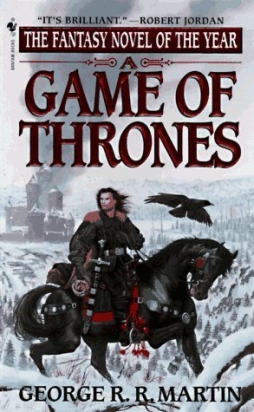 Martin describes the things of his world with a sense of aesthetic beauty, and with what almost seems to be joy. Clothing and food, weapons and armour, castles and cityscapes; all of these are made real for the reader, and so make the setting as a whole that much more vivid — not only because we can see or smell or taste the things themselves, but because the nature of those things helps define the cultures that produce them. The shape or design of the decorations of a helmet, or the kinds of cloth and embroidery that go into a gown, or the spices used in an elaborate meal, tell us something about the world from which they came; and what people expect, and what their sense of aesthetics is like, and even how complex trade between nations can be (bringing spices and silks and such from one land to another).
Martin describes the things of his world with a sense of aesthetic beauty, and with what almost seems to be joy. Clothing and food, weapons and armour, castles and cityscapes; all of these are made real for the reader, and so make the setting as a whole that much more vivid — not only because we can see or smell or taste the things themselves, but because the nature of those things helps define the cultures that produce them. The shape or design of the decorations of a helmet, or the kinds of cloth and embroidery that go into a gown, or the spices used in an elaborate meal, tell us something about the world from which they came; and what people expect, and what their sense of aesthetics is like, and even how complex trade between nations can be (bringing spices and silks and such from one land to another).
Everyday life comes alive in Martin’s descriptions. There’s actually a website that presents recipes based on the meals Martin describes, and it’s about to spin off an actual cookbook. It’s all fascinating, that life, and it feels like fantasy even without explicit magic — because it’s so different from our world and our experience, because it’s a world of knights and pre-industrial technology and wooden sailing ships, because it’s filled with proverbs and legends and wonder-stories about its own history; because, in fact, it is like our own history without being that history. The near-total absence of magic (especially in the first book) almost lulls us into treating it as a world with absolute physical laws like our own. Which is to say that the mundanity of his world feels real, and that helps set up the moments where magic and fantasy take over; after being grounded in such a highly-realised physical setting, the points where we go beyond the everyday into the supernatural feel almost like encountering magic or dragons in the real world.
I’d say Martin also presents these descriptions without sacrificing pace; or, more precisely, he has a fine sense of when to let the story speed up and when to slow it down. And a sense of how to work these descriptions into the unfolding of the tale. So, for me, Martin’s style works to build his world and story at once; to create a vivid setting.
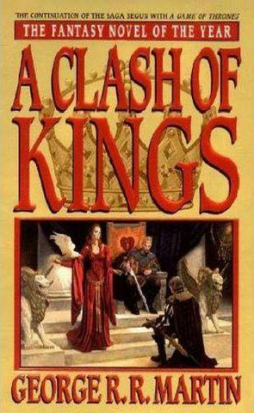 But I think it also helps to establish plot and character in fairly subtle ways. As I mentioned, one of the recurring devices in the books is the way in which different characters see the same thing in different ways. Sometimes that’s purely a function of the characters bringing different preconceptions to the things that they see; the various first impressions different characters have of the dwarfish Tyrion being a good example. In other cases that can be a hint at some plot element. A character drops out of sight in one part of the world; another character is introduced on another continent; eventually we find the two are one and the same. The way Martin does this sort of thing repeatedly tends to destabilise the things we thought we knew, and set up mysteries which are still unfolding — if they’re mysteries at all. If one character describes a woman as having broad child-bearing hips, and then another character describes her as being notably thin-hipped, is that a function of them looking at the same person differently, or are they in fact seeing two different people, the second of whom is masquerading as the first?
But I think it also helps to establish plot and character in fairly subtle ways. As I mentioned, one of the recurring devices in the books is the way in which different characters see the same thing in different ways. Sometimes that’s purely a function of the characters bringing different preconceptions to the things that they see; the various first impressions different characters have of the dwarfish Tyrion being a good example. In other cases that can be a hint at some plot element. A character drops out of sight in one part of the world; another character is introduced on another continent; eventually we find the two are one and the same. The way Martin does this sort of thing repeatedly tends to destabilise the things we thought we knew, and set up mysteries which are still unfolding — if they’re mysteries at all. If one character describes a woman as having broad child-bearing hips, and then another character describes her as being notably thin-hipped, is that a function of them looking at the same person differently, or are they in fact seeing two different people, the second of whom is masquerading as the first?
Plot twists are of course a common part of storytelling. Martin’s twists seem a little different; they’re put out there for you to notice, if you can make the connection. He’s perfectly up front in the way he links people and things by recurring imagery. His concrete descriptions work to say more than they appear to; the clues are there, if you can spot them.
To phrase it like that is to emphasise the resemblance of Martin’s technique to mystery fiction. Perhaps it’d be more appropriate to consider the books as a series of riddles. In its traditional form, a riddle is a phrase or poem that seems to be describing one thing, but actually has another in mind. I think much of Martin’s plot construction seems to derive from that kind of approach. It’s hardly a new technique in fantasy, but I wonder if he doesn’t rely on it more than other writers, and also weave his riddles deeper into the bedrock of the tale.
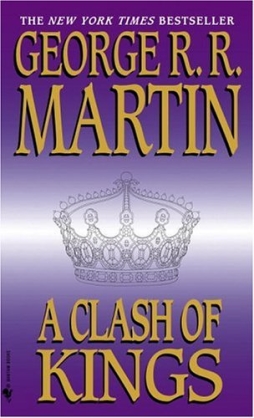 (For what it’s worth, it also seems to me that this is perhaps the only notable similarity his books have with the Harry Potter books: both series rely on the unravelling of riddles, in the individual books and over the course of the saga as a whole. You can see the resemblance in, for example, the way both Rowling and Martin use the old technique of introducing a prophecy, and then having it be fulfilled in a way that technically fits the language of the prophecy but which couldn’t really be guessed beforehand.)
(For what it’s worth, it also seems to me that this is perhaps the only notable similarity his books have with the Harry Potter books: both series rely on the unravelling of riddles, in the individual books and over the course of the saga as a whole. You can see the resemblance in, for example, the way both Rowling and Martin use the old technique of introducing a prophecy, and then having it be fulfilled in a way that technically fits the language of the prophecy but which couldn’t really be guessed beforehand.)
I think Martin’s technique here happens to be the perfect storytelling approach for the internet age. It gives birth to any number of theories, as fans pore over every word of the text and debate possible meanings and connections with other fans. Elaborate twists are given their own shorthand, algebraic-sounding formulae like “R+L=J” or “A+J=T”. The books become more than an experience of their own; they birth an ongoing discussion, a group exegesis with its own conventions and controversies.
You could perhaps argue that in some ways it’s is a play upon typical fantasy writing. If (and I’m not entirely convinced this is the case) traditional fantasy tends to make good guys be visibly attractive and evil-doers visibly ugly; if (and I’m not sure how much this is the case either) fantasy fiction has its roots in the racialist thinking of the early twentieth century — a concern with ‘races’ as genetically discrete groups which have specific cultural rises and falls, and which are marked by things such as eye colour and hair colour — then Martin’s story, in which similarities of physical descriptions can indicate secrets of a character’s parentage, can be a kind of modernisation or subversion of these tendencies.
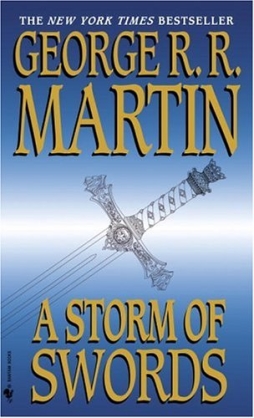 But I think it’s clear that Martin’s sense of what to say and when to say it plays into the structure he uses, of limited third person points-of-view, in such a way as to illustrate his themes. We see the world through his characters’ eyes, and because of this not only do we perceive the world as a set of riddles that no one person can wholly grasp, but we have the chance to solve those riddles for ourselves — once we figure out how the nature of the individual characters shapes what they’re seeing, and what it is that they notice around them.
But I think it’s clear that Martin’s sense of what to say and when to say it plays into the structure he uses, of limited third person points-of-view, in such a way as to illustrate his themes. We see the world through his characters’ eyes, and because of this not only do we perceive the world as a set of riddles that no one person can wholly grasp, but we have the chance to solve those riddles for ourselves — once we figure out how the nature of the individual characters shapes what they’re seeing, and what it is that they notice around them.
Noble characters don’t see characters from lower social classes. Men and women have their perceptions of each other shaped by their experiences and prejudices and (to an extent) sexualities. Each character has a perspective on the world, and tends to see the things that confirm them in that perspective. Which is much like life.
To an extent this depth of understanding of character is what you want to see in any well-written book, but Martin uses that understanding of character to make his story more immersive, to layer it in riddles. The clarity of his storytelling style furthers this technique, as character after character presents pieces of the world, tells us what they see and what they understand, but leaves it to us to integrate all these perspectives into a (hopefully) greater understanding.
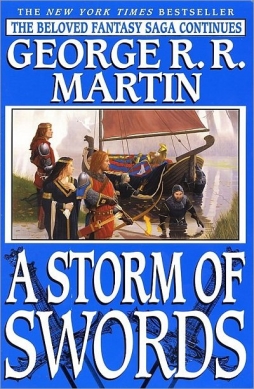 I think the use of multiple perspectives in the books, and the way the perspectives multiply in each volume, is one of the most structurally intriguing devices of the series. It reinforces the point that everybody’s the hero of their own tale. It shows us characters from different angles. It impresses upon us the fact that no individual has a monopoly on the truth; nobody understands everything. We think we see what’s going on; we think we’ve solved a mystery; then another perspective reveals another layer of plotting or of politics underneath it. Martin even gets away with hiding the answers to some obvious mysteries (who sent the assassin after Bran?) behind multiple layers of answers, some of which satisfy some characters and some of which must await the later investigation of others.
I think the use of multiple perspectives in the books, and the way the perspectives multiply in each volume, is one of the most structurally intriguing devices of the series. It reinforces the point that everybody’s the hero of their own tale. It shows us characters from different angles. It impresses upon us the fact that no individual has a monopoly on the truth; nobody understands everything. We think we see what’s going on; we think we’ve solved a mystery; then another perspective reveals another layer of plotting or of politics underneath it. Martin even gets away with hiding the answers to some obvious mysteries (who sent the assassin after Bran?) behind multiple layers of answers, some of which satisfy some characters and some of which must await the later investigation of others.
In the end, I think the unreliability of the narrators of the story serve to point up one of the books’ themes: the falsity of any story. Words are wind, we’re told again and again. We see how a given event becomes fabulised, distorted into rumour or propaganda the further we get from it. And so it is with the story that contains all these stories, A Song of Ice and Fire itself.
Martin invites us again and again to withhold trust from the things we’re told, but again and again reveals to us how much we’ve accepted without realising it. It’s a nice trick; and it surprises me that he’s consistently able to pull it off without alienating his readership. I think the secret is that he plays fair with the readers. He puts his clues out there in the descriptions he gives; he shows us, by revealing a few minor mysteries, how his riddles are constructed. And if, given that, you’re still surprised by what happens — it’s hardly his fault, is it? Words are wind.
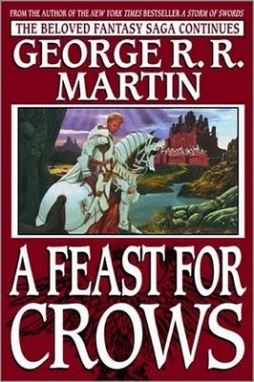 But if the unreliability of storytelling is part of what the books seem to be about, I think Martin’s playing about with other notions as well, related to his use of point-of-view and his mosaic structure. For example, there’s an interesting passage in the new book where a historically-minded character questions the real viability of violence as a way of solving problems; and, without getting too deeply into that specific passage, I do think the books are concerned with the futility of violence. Also, in a related way, with the futility of history; with violence spawned by a certain understanding of history, with stories about feuds and ancestors and cultures that set people and armies against one another. Words are wind; but winds can drive ships and uproot trees. Words can drive armies and uproot kingdoms.
But if the unreliability of storytelling is part of what the books seem to be about, I think Martin’s playing about with other notions as well, related to his use of point-of-view and his mosaic structure. For example, there’s an interesting passage in the new book where a historically-minded character questions the real viability of violence as a way of solving problems; and, without getting too deeply into that specific passage, I do think the books are concerned with the futility of violence. Also, in a related way, with the futility of history; with violence spawned by a certain understanding of history, with stories about feuds and ancestors and cultures that set people and armies against one another. Words are wind; but winds can drive ships and uproot trees. Words can drive armies and uproot kingdoms.
I think all of this boils down to themes of identity. You can see it in the way Martin handles his structure. He identifies the viewpoint character for each of his chapters by using the character’s name as the chapter title; in the last couple of books he’s played about with that, identifying chapters with names that characters have had forced upon them, or indeed using roles instead of names, so that he calls into question the identity of the characters — and makes the reader wonder both who they really are, and who they think they are. Martin gets at some remarkable effects in doing so. A partial spoiler for the new book: one character, who I’d frankly never been especially interested in, has a particularly compelling arc which is highlighted by the different names that open his viewpoint chapters, reflecting the different ways he thinks about himself. This character works through the identities forced upon him over the course of a kind of healing back to something like what he used to be, with the result that when the name we used to know him by appears once again, it’s almost a stand-up-and-cheer moment; a confirmation that somebody who’s been through all kinds of hell has nevertheless recovered.
More broadly, the way Martin uses his play with riddles to make us question what we think we know about who his characters are — their parentage, their morals, their goals — leads us to see their identities as being in flux. And along with those identities, the world as a whole. We learn in the first book, for example, that a minor character is a bastard son of a king. But the son in question doesn’t know this. What happens when he finds out, if he finds out? Does it change who he is? Will it affect the whirl of politics? We don’t know. Nothing is certain.
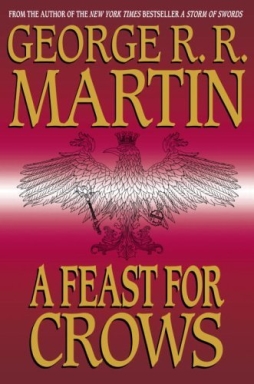 Look at how often characters appear in disguise. Sometimes we know who they are; sometimes we don’t. Characters speculate about other characters. Sometimes we find out they were right to wonder; sometimes we don’t. Sometimes we find out they were wrong. Identity is protean, but limiting; one person can never actually be another person, even if it’s in someone’s interest to make the world believe they are that other. But at the same time, one identity can be (partly) dropped and another assumed just by putting on a black cloak. Or a stolen suit of armour.
Look at how often characters appear in disguise. Sometimes we know who they are; sometimes we don’t. Characters speculate about other characters. Sometimes we find out they were right to wonder; sometimes we don’t. Sometimes we find out they were wrong. Identity is protean, but limiting; one person can never actually be another person, even if it’s in someone’s interest to make the world believe they are that other. But at the same time, one identity can be (partly) dropped and another assumed just by putting on a black cloak. Or a stolen suit of armour.
Identity, in other words, is a riddle. It is a riddle that can in part be solved, by careful attention to detail. But perhaps it also cannot be solved; perhaps there’s always more behind it, or perhaps there are things we cannot get away from. At any rate, by filling his books with riddles, by making riddles and the limitations of individual perspectives part of the structural core of his story, Martin’s making us think about identity in a certain way. He leads us to identify with his characters — the ultimate riddle of any storytelling endeavour: why should the audience care? — even when we don’t know who they really are. We can only read carefully, and ponder what we’re told and who tells it to us; and guess at all the answers we can’t know.
I think Martin’s style, his clarity and use of concrete detail, help set up his use of multiple perspectives and his play with identity. Which is to say that I think his style reflects the structure of the books, and that both style and structure reflect the themes I think he’s playing with. Where it’s all going, I don’t know. I can’t know, until the whole thing’s done. But I’m impressed with what Martin’s done so far; impressed with how it’s all both developing into new areas and also coming together, and impressed with what A Dance With Dragons does for the story as a whole. I don’t think this is a flawless series, but I think there’s much good in it, and I’m very much looking forward to seeing further installments.
Matthew David Surridge is the author of “The Word of Azrael,” from Black Gate 14. His new ongoing web serial is The Fell Gard Codices. You can find him on facebook, or follow his Twitter account, Fell_Gard.
Well said. I’m about halfway through the book now and liking it more than _Feast for Crows_. I also read your review in the _Gazette_ and found the comparison to a symphony apt. _A Song of Ice and Fire_ is a lot like a Mahler symphony-dense, layered, constantly shifting yet with recurring motifs and themes, some of wonderful simplicity while other are mind-bending in complexity.
[…] to head to Westeros still. There’s just no pull factor yet. A pretty good analysis of the series: Black Gate Blog Archive Ruminations on Ice and Fire […]
Before I read Game of Thrones back in 98, Fantasy was just another genre of about 4 or 5 that I read. After I read it, fantasy became my favorite genre because Martin showed me that it could be taken to level. The realism, relatable characters, and the rich descriptive writing made the imaginary trip to Westeros and the land beyond easy. The acts of heroism in such a very dark and violent world, shine through all the more, which made me want to stay there once I made that imaginary journey.
But as the number of years between books kept increasing, my passion gave way to frustration and even small amount of anger, because of what seems almost like an arrogant disdain by Martin when patience of his many of his fans wore thin.
All that said, I pre-ordered the Amazon Kindle version Dance with Dragons and excited to find it on my Kindle on the release date.
I’m a little more than a third of the way into it, and I’m a fan all over again.